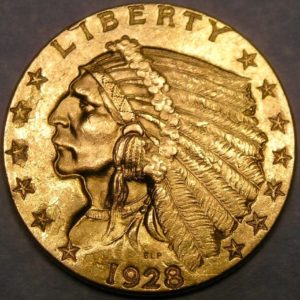Indian Head $2.50 Gold Quarter Eagle (1908-1929)
When the 20th century began, the design for the four gold coins that were then being made by the US government had been the same for fifty years. Many felt that this was a sign of a need for change and improvement. In 1901, Theodore Roosevelt agreed. Ever a proponent of and strong trigger for change, Roosevelt believed that an update to the gold coins of the US were far past due. With this in his mind, he commissioned Bela Lyon Pratt to redesign two of the four gold coins, one of which would be the Indian Head $2.50 Gold Quarter Eagle.
The main figure on the coin is an Indian chieftain with a bonnet the word ‘LIBERTY’ inscribed above him. On the reverse side is the conventional American symbol of an eagle, perched proudly and protectively. Pratt managed, through skillful arrangement, to depict four inscriptions along the side of the coin, these being ‘UNITED STATES OF AMERICA’, ‘E PLURIBUS UNUM’, ‘IN GOD WE TRUST’, and the value of the coin. 
The Indian Head was initially met with ambivalence. While most people found the artistic design to be impressive, there were still several criticisms raised. There were questions about the proper representation of the two figures on the coin, the Indian and the eagle. Many also felt uncomfortable with some of the more unfamiliar elements of the coin. President Roosevelt, however, remained firmly dedicated to the coin and continued to back it.
From 1908 to 1915 the Indian Head Quarter Eagle was issued every year. After this period, the coin was temporarily discontinued for a decade. It returned in 1925 but was again discontinued (this time permanently) as a result of the Wall Street Crash of 1929. Gold became something of a scarce resource for the government during the Great Depression and was needed for Double Eagle coins rather than Quarter Eagles like the Indian Head.
The Indian Head Quarter Eagle has only 15 date and mint combinations. This makes the series one of the smallest sets in the history of US coinage and many collectors therefore find it highly attractive to purchase the entire series despite the generally high cost of gold. Another contributing factor to its cost effectiveness is the fact that most of the combinations aren’t particularly rare, with only one or two real exceptions. There remain, however, issues with grading as these coins are particularly protected against wearing and thus it can be harder to separate the higher quality coins from the lower.
In any case, this coin remains a highly attractive choice for collectors even if one only looks at it from a historical standpoint. The Indian Head represents an era of change and upheaval, where massive changes were being made to convention and the status quo. Additionally, it also represents a transition in the production of American coins, being among the last of the Quarter Eagles. Because of this, the coin can be seen as a remnant both of an era of progress and an era of transformation.
